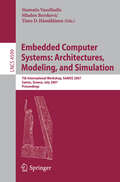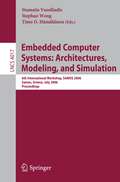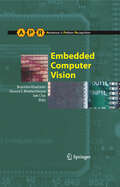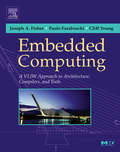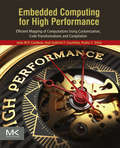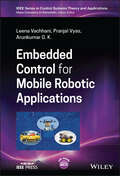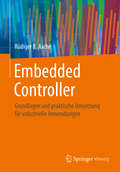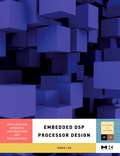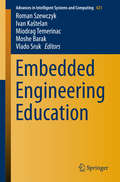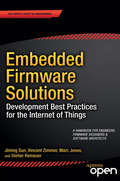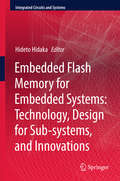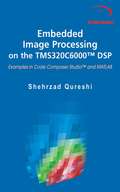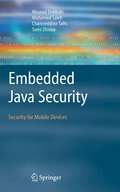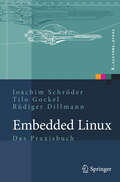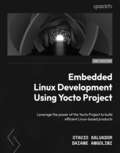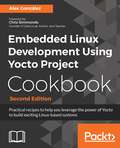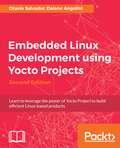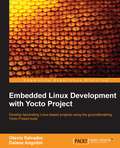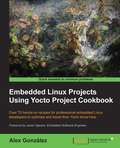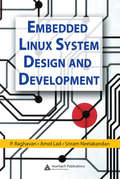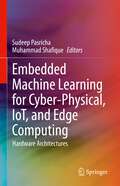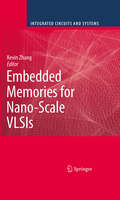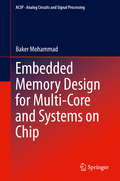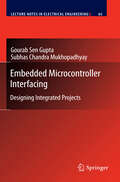- Table View
- List View
Embedded Computer Systems: 7th International Workshop, SAMOS 2007, Samos, Greece, July 16-19, 2007, Proceedings (Lecture Notes in Computer Science #4599)
by Stamatis Vassiliadis Mladen Berekovic Timo D. HämäläinenResearchers and professionals in the appropriate subject areas will find this book an essential update on where research has got to in what is, after all, a hugely important area. It constitutes the refereed proceedings of the 7th International Workshop on Systems, Architectures, Modeling, and Simulation, held in Samos, Greece, in July 2007. The 44 revised full papers presented together with 2 keynote talks were thoroughly reviewed and selected from 116 submissions
Embedded Computer Systems: 6th International Workshop, SAMOS 2006, Samos, Greece, July 17-20, 2006, Proceedings (Lecture Notes in Computer Science #4017)
by Stamatis Vassiliadis Stephan Wong Timo D. HämäläinenThis book constitutes the refereed proceedings of the 6th International Workshop on Systems, Architectures, Modeling, and Simulation, SAMOS 2006, held in Samos, Greece on July 2006. The 47 revised full papers presented together with 2 keynote talks were thoroughly reviewed and selected from 130 submissions. The papers are organized in topical sections on system design and modeling, wireless sensor networks, processor design, dependable computing, architectures and implementations, and embedded sensor systems.
Embedded Computer Vision (Advances in Computer Vision and Pattern Recognition)
by Shuvra S. Bhattacharyya Sek Chai Branislav KisacaninAs a graduate student at Ohio State in the mid-1970s, I inherited a unique c- puter vision laboratory from the doctoral research of previous students. They had designed and built an early frame-grabber to deliver digitized color video from a (very large) electronic video camera on a tripod to a mini-computer (sic) with a (huge!) disk drive—about the size of four washing machines. They had also - signed a binary image array processor and programming language, complete with a user’s guide, to facilitate designing software for this one-of-a-kindprocessor. The overall system enabled programmable real-time image processing at video rate for many operations. I had the whole lab to myself. I designed software that detected an object in the eldofview,trackeditsmovementsinrealtime,anddisplayedarunningdescription of the events in English. For example: “An object has appeared in the upper right corner...Itismovingdownandtotheleft...Nowtheobjectisgettingcloser...The object moved out of sight to the left”—about like that. The algorithms were simple, relying on a suf cient image intensity difference to separate the object from the background (a plain wall). From computer vision papers I had read, I knew that vision in general imaging conditions is much more sophisticated. But it worked, it was great fun, and I was hooked.
Embedded Computing: A VLIW Approach to Architecture, Compilers and Tools
by Joseph A. Fisher Paolo Faraboschi Cliff YoungThe fact that there are more embedded computers than general-purpose computers and that we are impacted by hundreds of them every day is no longer news. What is news is that their increasing performance requirements, complexity and capabilities demand a new approach to their design. Fisher, Faraboschi, and Young describe a new age of embedded computing design, in which the processor is central, making the approach radically distinct from contemporary practices of embedded systems design. They demonstrate why it is essential to take a computing-centric and system-design approach to the traditional elements of nonprogrammable components, peripherals, interconnects and buses. These elements must be unified in a system design with high-performance processor architectures, microarchitectures and compilers, and with the compilation tools, debuggers and simulators needed for application development. In this landmark text, the authors apply their expertise in highly interdisciplinary hardware/software development and VLIW processors to illustrate this change in embedded computing. VLIW architectures have long been a popular choice in embedded systems design, and while VLIW is a running theme throughout the book, embedded computing is the core topic. Embedded Computing examines both in a book filled with fact and opinion based on the authors many years of R&D experience.· Complemented by a unique, professional-quality embedded tool-chain on the authors' website, http://www.vliw.org/book· Combines technical depth with real-world experience · Comprehensively explains the differences between general purpose computing systems and embedded systems at the hardware, software, tools and operating system levels. · Uses concrete examples to explain and motivate the trade-offs.
Embedded Computing for High Performance: Efficient Mapping of Computations Using Customization, Code Transformations and Compilation
by Pedro C. Diniz João Manuel Cardoso José Gabriel CoutinhoEmbedded Computing for High Performance: Design Exploration and Customization Using High-level Compilation and Synthesis Tools provides a set of real-life example implementations that migrate traditional desktop systems to embedded systems. Working with popular hardware, including Xilinx and ARM, the book offers a comprehensive description of techniques for mapping computations expressed in programming languages such as C or MATLAB to high-performance embedded architectures consisting of multiple CPUs, GPUs, and reconfigurable hardware (FPGAs). The authors demonstrate a domain-specific language (LARA) that facilitates retargeting to multiple computing systems using the same source code. In this way, users can decouple original application code from transformed code and enhance productivity and program portability. After reading this book, engineers will understand the processes, methodologies, and best practices needed for the development of applications for high-performance embedded computing systems.Focuses on maximizing performance while managing energy consumption in embedded systemsExplains how to retarget code for heterogeneous systems with GPUs and FPGAsDemonstrates a domain-specific language that facilitates migrating and retargeting existing applications to modern systemsIncludes downloadable slides, tools, and tutorials
Embedded Control for Mobile Robotic Applications (IEEE Press Series on Control Systems Theory and Applications)
by Leena Vachhani Pranjal Vyas Arunkumar G. K.An all-in-one resource for designing and implementing embedded control in mobile robotics In Embedded Control for Mobile Robotic Applications, a distinguished trio of researchers delivers an authoritative and fulsome resource for understanding embedded control and robotics. The book includes coverage of a variety of embedded platforms, their use in controller implementation, stability analyses of designed controllers, and two new approaches for designing embedded controllers. The authors offer a full chapter on Field-Programmable-Gate-Array (FPGA) architecture development for controller design that is perfect for both practitioners and students taking robotics courses and provide a companion website that includes MATLAB codes for simulation and embedded platform-specific code for mobile robotic applications (in Embedded C and Verilog). The two approaches discussed by the authors—the top-down methodology and the bottom-up methodology—are of immediate practical utility to both practicing professionals in the field and students studying control applications and mobile robotics. The book also offers: A thorough introduction to embedded control, including processor, IC, and design technology, as well as a discussion of limitations in embedded control design Comprehensive explorations of the bottom-up and top-down methods, including computations using CORDIC, interval arithmetic, sliding surface design, and switched nonlinear systems Practical discussions of generic FPGA architecture design, including Verilog, PID controllers, DC motors and Encoder, and a systematic approach for designing architecture using FSMD In-depth examinations of discrete-time controller design, including the approximation to discrete-time transfer function and embedded implementation stability Perfect for practitioners working in embedded control design and control applications in robotics, Embedded Control for Mobile Robotic Applications will also earn a place in the libraries of academicians, researchers, senior undergraduate students, and graduate students in these fields.
Embedded Control for Mobile Robotic Applications (IEEE Press Series on Control Systems Theory and Applications)
by Leena Vachhani Pranjal Vyas Arunkumar G. K.An all-in-one resource for designing and implementing embedded control in mobile robotics In Embedded Control for Mobile Robotic Applications, a distinguished trio of researchers delivers an authoritative and fulsome resource for understanding embedded control and robotics. The book includes coverage of a variety of embedded platforms, their use in controller implementation, stability analyses of designed controllers, and two new approaches for designing embedded controllers. The authors offer a full chapter on Field-Programmable-Gate-Array (FPGA) architecture development for controller design that is perfect for both practitioners and students taking robotics courses and provide a companion website that includes MATLAB codes for simulation and embedded platform-specific code for mobile robotic applications (in Embedded C and Verilog). The two approaches discussed by the authors—the top-down methodology and the bottom-up methodology—are of immediate practical utility to both practicing professionals in the field and students studying control applications and mobile robotics. The book also offers: A thorough introduction to embedded control, including processor, IC, and design technology, as well as a discussion of limitations in embedded control design Comprehensive explorations of the bottom-up and top-down methods, including computations using CORDIC, interval arithmetic, sliding surface design, and switched nonlinear systems Practical discussions of generic FPGA architecture design, including Verilog, PID controllers, DC motors and Encoder, and a systematic approach for designing architecture using FSMD In-depth examinations of discrete-time controller design, including the approximation to discrete-time transfer function and embedded implementation stability Perfect for practitioners working in embedded control design and control applications in robotics, Embedded Control for Mobile Robotic Applications will also earn a place in the libraries of academicians, researchers, senior undergraduate students, and graduate students in these fields.
Embedded Controller: Grundlagen und praktische Umsetzung für industrielle Anwendungen
by Rüdiger R. AscheDas Buch gewährt einen Einblick in die Architektur eingebetteter Systeme und den Entwicklungsprozess für die sie steuernde Firmware. Die Anforderungen an ein unbeaufsichtigt laufendes Embedded System sowie deren Umsetzung stehen dabei im Fokus. Alle Konzepte werden anhand von verbreiteten Komponenten wie ARM® Cortex® M3 und M4 basierten Prozessoren, FreeRTOS oder lwip praktisch umgesetzt. Praxistipps zur effizienten und zielgerichteten Nutzung von Debug-, Einkapselungs- und Analysewerkzeugen runden das Buch ab. Sie helfen sowohl dem Einsteiger als auch dem erfahrenen Profi bei der Entwicklung robuster und wartungsfreundlicher Firmware für Mikrocontroller im eingebetteten Umfeld.
Embedded DSP Processor Design: Application Specific Instruction Set Processors (ISSN #Volume 2)
by Dake LiuThis book provides design methods for Digital Signal Processors and Application Specific Instruction set Processors, based on the author's extensive, industrial design experience. Top-down and bottom-up design methodologies are presented, providing valuable guidance for both students and practicing design engineers. Coverage includes design of internal-external data types, application specific instruction sets, micro architectures, including designs for datapath and control path, as well as memory sub systems. Integration and verification of a DSP-ASIP processor are discussed and reinforced with extensive examples.Instruction set design for application specific processors based on fast application profilingMicro architecture design methodologyMicro architecture design details based on real examples Extendable architecture design protocolsDesign for efficient memory sub systems (minimizing on chip memory and cost)Real example designs based on extensive, industrial experiences
Embedded Engineering Education (Advances in Intelligent Systems and Computing #421)
by Roman Szewczyk Ivan Kaštelan Miodrag Temerinac Moshe Barak Vlado SrukThis book focuses on the outcome of the European research project “FP7-ICT-2011-8 / 317882: Embedded Engineering Learning Platform” E2LP. Additionally, some experiences and researches outside this project have been included. This book provides information about the achieved results of the E2LP project as well as some broader views about the embedded engineering education. It captures project results and applications, methodologies, and evaluations. It leads to the history of computer architectures, brings a touch of the future in education tools and provides a valuable resource for anyone interested in embedded engineering education concepts, experiences and material. The book contents 12 original contributions and will open a broader discussion about the necessary knowledge and appropriate learning methods for the new profile of embedded engineers. As a result, the proposed Embedded Computer Engineering Learning Platform will help to educate a sufficient number of future engineers in Europe, capable of designing complex systems and maintaining a leadership in the area of embedded systems, thereby ensuring that our strongholds in automotive, avionics, industrial automation, mobile communications, telecoms and medical systems are able to develop.
Embedded Firmware Solutions: Development Best Practices for the Internet of Things
by Vincent Zimmer Jiming Sun Marc Jones Stefan ReinauerEmbedded Firmware Solutions is the perfect introduction and daily-use field guide--for the thousands of firmware designers, hardware engineers, architects, managers, and developers--to Intel’s new firmware direction (including Quark coverage), showing how to integrate Intel® Architecture designs into their plans.Featuring hands-on examples and exercises using Open Source codebases, like Coreboot and EFI Development Kit (tianocore) and Chromebook, this is the first book that combines a timely and thorough overview of firmware solutions for the rapidly evolving embedded ecosystem with in-depth coverage of requirements and optimization.
Embedded Flash Memory for Embedded Systems: Technology, Design For Sub-systems And Innovations (Integrated Circuits and Systems)
by Hideto HidakaThis book provides a comprehensive introduction to embedded flash memory, describing the history, current status, and future projections for technology, circuits, and systems applications. The authors describe current main-stream embedded flash technologies from floating-gate 1Tr, floating-gate with split-gate (1.5Tr), and 1Tr/1.5Tr SONOS flash technologies and their successful creation of various applications. Comparisons of these embedded flash technologies and future projections are also provided. The authors demonstrate a variety of embedded applications for auto-motive, smart-IC cards, and low-power, representing the leading-edge technology developments for eFlash. The discussion also includes insights into future prospects of application-driven non-volatile memory technology in the era of smart advanced automotive system, such as ADAS (Advanced Driver Assistance System) and IoE (Internet of Everything). Trials on technology convergence and future prospects of embedded non-volatile memory in the new memory hierarchy are also described.Introduces the history of embedded flash memory technology for micro-controller products and how embedded flash innovations developed;Includes comprehensive and detailed descriptions of current main-stream embedded flash memory technologies, sub-system designs and applications;Explains why embedded flash memory requirements are different from those of stand-alone flash memory and how to achieve specific goals with technology development and circuit designs;Describes a mature and stable floating-gate 1Tr cell technology imported from stand-alone flash memory products - that then introduces embedded-specific split-gate memory cell technologies based on floating-gate storage structure and charge-trapping SONOS technology and their eFlash sub-system designs;Describes automotive and smart-IC card applications requirements and achievements in advanced eFlash beyond 40nm node.
Embedded Image Processing on the TMS320C6000™ DSP: Examples in Code Composer Studio™ and MATLAB
by Shehrzad QureshiThis is an application-oriented book includes debugged & efficient C implementations of real-world algorithms, in a variety of languages/environments, offering unique coverage of embedded image processing. covers TI technologies and applies them to an important market (important: features the C6416 DSK)Also covers the EVM should not be lost, especially the C6416 DSK, a much more recent DSP.Algorithms treated here are frequently missing from other image processing texts, in particular Chapter 6 (Wavelets), moreover, efficient fixed-point implementations of wavelet-based algorithms also treated.Provide numerous Visual Studio .NET 2003 C/C++ code, that show how to use MFC, GDI+, and the Intel IPP library to prototype image processing applications
Embedded Java Security: Security for Mobile Devices
by Mourad Debbabi Mohamed Saleh Chamseddine Talhi Sami ZhiouaThis book is a comprehensive presentation of embedded Java security. It is compared with the security model of the Java 2 Standard Edition in order to view the impact of limited resources on security. No other book specifically addresses the topic of embedded Java security. Furthermore, the book provides hints and suggestions as ways for hardening security, and offers researchers and practitioners alike a broader and deeper understanding of the issues involved in embedded Java security, and – as a larger view - mobile devices security. The author is a well-known authority and expert in mobile computing and embedded devices.
Embedded Linux: Das Praxisbuch (X.systems.press)
by Joachim Schröder Tilo Gockel Rüdiger DillmannEingebettete Systeme steuern unbemerkt die Waschmaschine oder als Digitaler Sound Prozessor das Autoradio. Der Autor stellt leistungsfähige Linux-Derivate vor, die den Komfort der Schnittstellentreiber, des Multi-Threadings und eines Dateisystems bieten. Alle Beispiele sind vollständig durchimplementiert und online frei verfügbar. Das Buch eignet sich als Begleitbuch für Administratoren und Linux-Anwender, hilft aber auch Entwicklern in der Industrie, bei diesem Trend den Anschluss nicht zu verlieren.
Embedded Linux Development Using Yocto Project: Leverage the power of the Yocto Project to build efficient Linux-based products
by Daiane Angolini Otavio SalvadorThe Yocto Project is the industry standard for developing dependable embedded Linux projects. It stands out from other frameworks by offering time-efficient development with enhanced reliability and robustness. With Embedded Linux Development Using Yocto Project, you’ll acquire an understanding of Yocto Project tools, helping you perform different Linux-based tasks. You’ll gain a deep understanding of Poky and BitBake, explore practical use cases for building a Linux subsystem project, employ Yocto Project tools available for embedded Linux, and uncover the secrets of SDK, recipe tool, and others. This new edition is aligned with the latest long-term support release of the aforementioned technologies and introduces two new chapters, covering optimal emulation in QEMU for faster product development and best practices. By the end of this book, you’ll be well-equipped to generate and run an image for real hardware boards. You’ll gain hands-on experience in building efficient Linux systems using the Yocto Project.Key FeaturesOptimize your Yocto Project tools to develop efficient Linux-based projects Follow a practical approach to learning Linux development using Yocto Project Employ the best practices for embedded Linux and Yocto Project developmentWhat you will learnGet to grips with Poky workflowsConfigure and prepare the Poky build environmentExplore the latest version of Yocto Project through examplesConfigure a build server and customize images using ToasterGenerate images and fit packages into created images using BitBakeSupport the development process by setting up and using Package feedsDebug Yocto Project by configuring PokyBuild and boot image for BeagleBone Black, RaspberryPi 4, and VisionFive via SD cardsExplore the use of QEMU to speed up the development cycle using emulationWho this book is forIf you are an embedded Linux developer and want to broaden your knowledge about the Yocto Project with examples of embedded development, then this book is for you. Professionals looking for new insights into working methodologies for Linux development will also find plenty of helpful information in this book.
Embedded Linux Development Using Yocto Project Cookbook.: Practical Recipes To Help You Leverage The Power Of Yocto To Build Exciting Linux-based Systems
by Alex GonzálezThe Yocto Project has become the de facto distribution build framework for reliable and robust embedded systems with a reduced time to market.
Embedded Linux Development using Yocto Projects
by Otavio SalvadorYocto Project is turning out to be the best integration framework for creating reliable embedded Linux projects. It has the edge over other frameworks because of its features such as less development time and improved reliability and robustness. Embedded Linux Development using Yocto Project starts with an in-depth explanation of all Yocto Project tools, to help you perform different Linux-based tasks. The book then moves on to in-depth explanations of Poky and BitBake. It also includes some practical use cases for building a Linux subsystem project using Yocto Project tools available for embedded Linux. The book also covers topics such as SDK, recipetool, and others. By the end of the book, you will have learned how to generate and run an image for real hardware boards and will have gained hands-on experience at building efficient Linux systems using Yocto Project.
Embedded Linux Development with Yocto Project
by Otavio Salvador Daiane AngoliniA practical tutorial guide which introduces you to the basics of Yocto Project, and also helps you with its real hardware use to boost your Embedded Linux-based project. If you are an embedded systems enthusiast and willing to learn about compelling features offered by the Yocto Project, then this book is for you. With prior experience in the embedded Linux domain, you can make the most of this book to efficiently create custom Linux-based systems.
Embedded Linux Projects Using Yocto Project Cookbook
by Alex GonzalezIf you are an embedded developer learning about embedded Linux with some experience with the Yocto project, this book is the ideal way to become proficient and broaden your knowledge with examples that are immediately applicable to your embedded developments. Experienced embedded Yocto developers will find new insight into working methodologies and ARM specific development competence.
Embedded Linux System Design and Development
by P. Raghavan Amol Lad Sriram NeelakandanBased upon the authors' experience in designing and deploying an embedded Linux system with a variety of applications, Embedded Linux System Design and Development contains a full embedded Linux system development roadmap for systems architects and software programmers. Explaining the issues that arise out of the use of Linux in embedded systems, the book facilitates movement to embedded Linux from traditional real-time operating systems, and describes the system design model containing embedded Linux. This book delivers practical solutions for writing, debugging, and profiling applications and drivers in embedded Linux, and for understanding Linux BSP architecture. It enables you to understand: various drivers such as serial, I2C and USB gadgets; uClinux architecture and its programming model; and the embedded Linux graphics subsystem. The text also promotes learning of methods to reduce system boot time, optimize memory and storage, and find memory leaks and corruption in applications. This volume benefits IT managers in planning to choose an embedded Linux distribution and in creating a roadmap for OS transition. It also describes the application of the Linux licensing model in commercial products.
Embedded Machine Learning for Cyber-Physical, IoT, and Edge Computing: Hardware Architectures
by Sudeep Pasricha Muhammad ShafiqueThis book presents recent advances towards the goal of enabling efficient implementation of machine learning models on resource-constrained systems, covering different application domains. The focus is on presenting interesting and new use cases of applying machine learning to innovative application domains, exploring the efficient hardware design of efficient machine learning accelerators, memory optimization techniques, illustrating model compression and neural architecture search techniques for energy-efficient and fast execution on resource-constrained hardware platforms, and understanding hardware-software codesign techniques for achieving even greater energy, reliability, and performance benefits.
Embedded Memories for Nano-Scale VLSIs (Integrated Circuits and Systems)
by Kevin ZhangKevin Zhang Advancement of semiconductor technology has driven the rapid growth of very large scale integrated (VLSI) systems for increasingly broad applications, incl- ing high-end and mobile computing, consumer electronics such as 3D gaming, multi-function or smart phone, and various set-top players and ubiquitous sensor and medical devices. To meet the increasing demand for higher performance and lower power consumption in many different system applications, it is often required to have a large amount of on-die or embedded memory to support the need of data bandwidth in a system. The varieties of embedded memory in a given system have alsobecome increasingly more complex, ranging fromstatictodynamic and volatile to nonvolatile. Among embedded memories, six-transistor (6T)-based static random access memory (SRAM) continues to play a pivotal role in nearly all VLSI systems due to its superior speed and full compatibility with logic process technology. But as the technology scaling continues, SRAM design is facing severe challenge in mainta- ing suf?cient cell stability margin under relentless area scaling. Meanwhile, rapid expansion in mobile application, including new emerging application in sensor and medical devices, requires far more aggressive voltage scaling to meet very str- gent power constraint. Many innovative circuit topologies and techniques have been extensively explored in recent years to address these challenges.
Embedded Memory Design for Multi-Core and Systems on Chip (Analog Circuits and Signal Processing #116)
by Baker MohammadThis book describes the various tradeoffs systems designers face when designing embedded memory. Readers designing multi-core systems and systems on chip will benefit from the discussion of different topics from memory architecture, array organization, circuit design techniques and design for test. The presentation enables a multi-disciplinary approach to chip design, which bridges the gap between the architecture level and circuit level, in order to address yield, reliability and power-related issues for embedded memory.
Embedded Microcontroller Interfacing: Designing Integrated Projects (Lecture Notes in Electrical Engineering #65)
by Gourab Sen GuptaMixed-Signal Embedded Microcontrollers are commonly used in integrating analog components needed to control non-digital electronic systems. They are used in automatically controlled devices and products, such as automobile engine control systems, wireless remote controllers, office machines, home appliances, power tools, and toys. Microcontrollers make it economical to digitally control even more devices and processes by reducing the size and cost, compared to a design that uses a separate microprocessor, memory, and input/output devices. In many undergraduate and post-graduate courses, teaching of mixed-signal microcontrollers and their use for project work has become compulsory. Students face a lot of difficulties when they have to interface a microcontroller with the electronics they deal with. This book addresses some issues of interfacing the microcontrollers and describes some project implementations with the Silicon Lab C8051F020 mixed–signal microcontroller. The intended readers are college and university students specializing in electronics, computer systems engineering, electrical and electronics engineering; researchers involved with electronics based system, practitioners, technicians and in general anybody interested in microcontrollers based projects.
